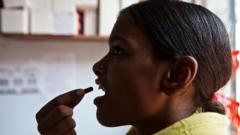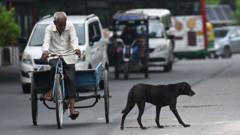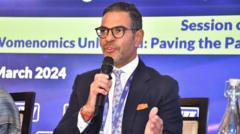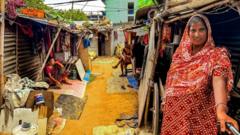A new report reveals that while antibiotic resistance rises, many in India remain untreated due to unavailable life-saving medications.
**Antibiotic Access Crisis in India: Superbugs Surge Amid Shortages**

**Antibiotic Access Crisis in India: Superbugs Surge Amid Shortages**
Deteriorating access to essential antibiotics exacerbates the superbug situation in India, leading to alarmingly high mortality rates.
India is currently grappling with a severe public health crisis driven by a dual challenge: the overuse of antibiotics and widespread inaccessibility to these essential drugs. As the country faces increasingly potent superbugs—particularly carbapenem-resistant Gram-negative (CRGN) bacteria—patients are often caught in a dire predicament of insufficient treatment options. A recent study conducted by the Global Antibiotic Research and Development Partnership (GARDP) highlights the struggle faced by nearly 1.5 million individuals suffering from CRGN infections across low- and middle-income nations, with India bearing the brunt of the crisis.
The GARDP report, published in The Lancet Infectious Diseases, revealed that despite India procuring a staggering 80% of the antibiotics necessary for treatment, only 7.8% of infected individuals received appropriate care. This paradox underscores a critical flaw in health care systems, whereby life-saving antibiotics remain unavailable to the most vulnerable populations. The implications are severe: CRGN bacteria are commonly found in our water, food, and even our own bodies, leading to various infections that threaten lives—especially in newborns, the elderly, and immunocompromised patients.
Echoing the gravity of the situation, Dr. Abdul Gaffar, an infectious disease consultant in Chennai, remarked on the grim reality of seeing patients for whom no antibiotic proves effective. “They die without treatment,” he lamented, underscoring how this reality contradicts the mainstream narrative that overuse of antibiotics is solely to blame for antibiotic resistance.
The research underscores that across India and other affected countries, there is a glaring discrepancy between antibiotic need and availability. As per Dr. Jennifer Cohn, a GARDP Global Access Director, many individuals with resistant infections are simply not able to access the antibiotics they desperately require. The GARDP study further examined eight critical intravenous medications necessary for combating carbapenem-resistant infections, revealing that the current procurement levels fall woefully short of the actual demand.
Obstacles to access these essential antibiotics abound—from inadequate health facilities and unreliable diagnostic tests to patients being unable to afford the necessary medications. Dr. Gaffar noted the irony that wealthier patients who can afford these drugs often overconsume them, while those in economic hardship remain unable to access even a single dose.
To remedy this situation, health professionals emphasize the need for implementing robust regulatory frameworks and ensuring equitable access to essential medications. Potential solutions include mandatory second approvals from specialists before prescribing certain antibiotics and improved cost management through coordinated procurement efforts among hospitals.
As India stands at the forefront of the battle against antimicrobial resistance (AMR), it also has the potential to spearhead innovative approaches to overcoming these challenges. Acknowledging the country’s significant pharmaceutical industry, experts see an opportunity for India to promote the development of new antibiotics. They suggest adopting localized data collection to identify gaps in treatment access and implementing novel healthcare strategies, such as Kerala’s "hub-and-spoke" model, to improve infection management across various healthcare facilities.
In conclusion, the ongoing fight against superbugs in India represents not just a public health crisis but a broader indicator of how access to vital medications can define patient outcomes. If healthcare systems can be strengthened, ensuring both access and responsible usage of antibiotics, India might lead the way towards mitigating the impacts of AMR, benefiting both its population and the global community.
The GARDP report, published in The Lancet Infectious Diseases, revealed that despite India procuring a staggering 80% of the antibiotics necessary for treatment, only 7.8% of infected individuals received appropriate care. This paradox underscores a critical flaw in health care systems, whereby life-saving antibiotics remain unavailable to the most vulnerable populations. The implications are severe: CRGN bacteria are commonly found in our water, food, and even our own bodies, leading to various infections that threaten lives—especially in newborns, the elderly, and immunocompromised patients.
Echoing the gravity of the situation, Dr. Abdul Gaffar, an infectious disease consultant in Chennai, remarked on the grim reality of seeing patients for whom no antibiotic proves effective. “They die without treatment,” he lamented, underscoring how this reality contradicts the mainstream narrative that overuse of antibiotics is solely to blame for antibiotic resistance.
The research underscores that across India and other affected countries, there is a glaring discrepancy between antibiotic need and availability. As per Dr. Jennifer Cohn, a GARDP Global Access Director, many individuals with resistant infections are simply not able to access the antibiotics they desperately require. The GARDP study further examined eight critical intravenous medications necessary for combating carbapenem-resistant infections, revealing that the current procurement levels fall woefully short of the actual demand.
Obstacles to access these essential antibiotics abound—from inadequate health facilities and unreliable diagnostic tests to patients being unable to afford the necessary medications. Dr. Gaffar noted the irony that wealthier patients who can afford these drugs often overconsume them, while those in economic hardship remain unable to access even a single dose.
To remedy this situation, health professionals emphasize the need for implementing robust regulatory frameworks and ensuring equitable access to essential medications. Potential solutions include mandatory second approvals from specialists before prescribing certain antibiotics and improved cost management through coordinated procurement efforts among hospitals.
As India stands at the forefront of the battle against antimicrobial resistance (AMR), it also has the potential to spearhead innovative approaches to overcoming these challenges. Acknowledging the country’s significant pharmaceutical industry, experts see an opportunity for India to promote the development of new antibiotics. They suggest adopting localized data collection to identify gaps in treatment access and implementing novel healthcare strategies, such as Kerala’s "hub-and-spoke" model, to improve infection management across various healthcare facilities.
In conclusion, the ongoing fight against superbugs in India represents not just a public health crisis but a broader indicator of how access to vital medications can define patient outcomes. If healthcare systems can be strengthened, ensuring both access and responsible usage of antibiotics, India might lead the way towards mitigating the impacts of AMR, benefiting both its population and the global community.






















